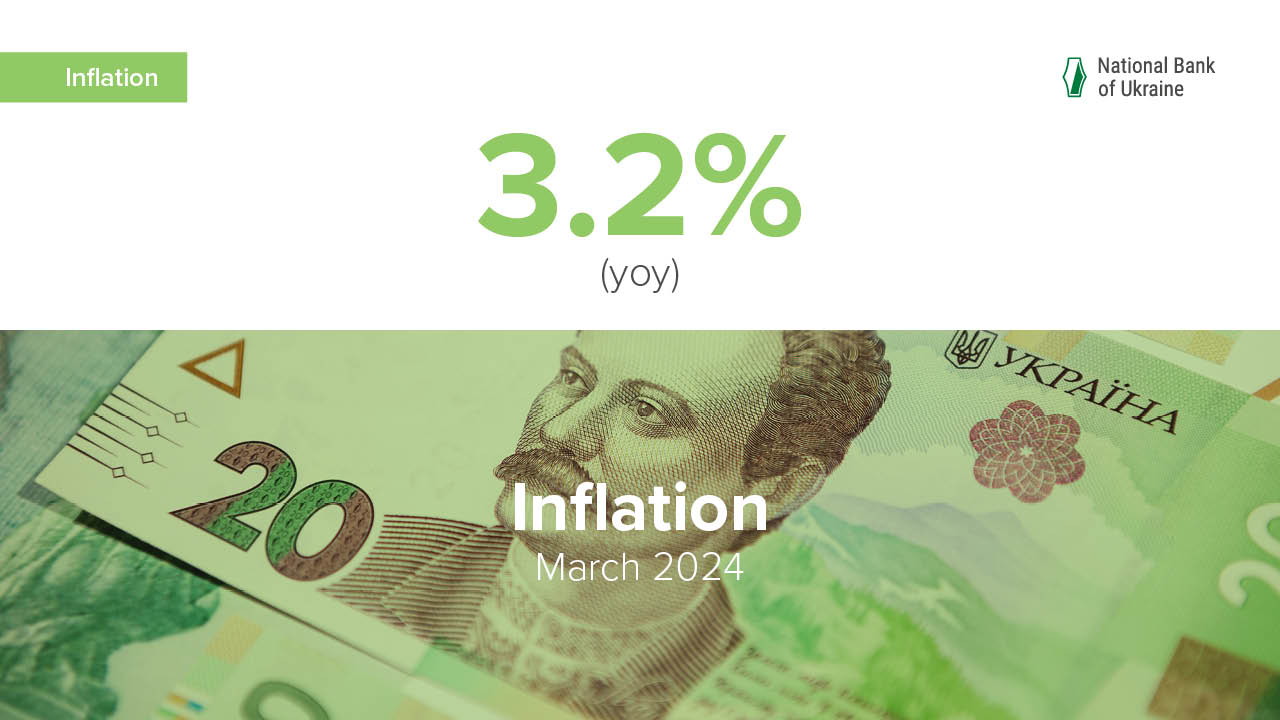In March 2024, consumer inflation declined in annual terms to 3.2%, down from 4.3% in February. In monthly terms, prices increased by 0.5%. This is according to data published by the State Statistics Service of Ukraine.
The actual rates of price growth were below the NBU’s forecast published in the January 2024 Inflation Report (5.0% yoy). The deviation from the forecast was driven by the dynamics of components that are hard to predict, primarily the prices of raw food products. The steeper decrease in raw food prices is primarily due to temporary factors whose effects will likely fade in H2 2024. Those include the effects of last year’s large harvests, this year’s mild winter, and the western borders transport blockade. Specifically, the restriction of exports fueled the growth in the supply of certain food products on the domestic market. In addition, fuel prices rose more slowly than expected, both due to a more restrained increase in world oil prices and because of a warm winter that led to a lower need for energy.
By contrast, underlying inflationary pressures that are the most affected by the NBU’s monetary policy eased off moderately and were close to the NBU’s forecast. In particular, core inflation slowed to 4.2% yoy in March, reflecting the pass-through effects from lower prices of raw foods, improved inflation expectations amid a relative sustainability of the FX market, and the preserved attractiveness of hryvnia instruments. At the same time, the more rapid deceleration of core inflation was restrained by the effects of the western borders blockade, primarily due to the increase in import prices, and by a further increase in businesses’ labor costs.
Raw food prices declined sharply by 4.9% yoy
Eggs continued to get cheaper as production grew, driven by second-round effects from significant harvests last year, and as producers temporarily shifted to the domestic market in view of the transport blockade. Last year’s high harvests also contributed to the fall in prices for sugar, flour, and cereals.
Borshch vegetables also fell in price due to mild winter weather and increased sales of products from storages. Thanks to the warm winter, the costs of growing and preserving greenhouse products declined, leading to a decrease in the prices of tomatoes and cucumbers. Prices for citrus fruits and bananas also went down. However, the prices of potatoes, beets, and apples remained high amid a limited supply of quality products.
The pace of growth in meat prices continued to abate, primarily due to cheaper feed. The increase in the price of pork slowed because of low demand and tighter competition between suppliers. For poultry, the pullback in price growth was due to increased production. The price of raw milk rose more slowly amid an increase in supply from private households and a reduced domestic demand.
Increases in administered prices slowed to 9.9% yoy
Alcoholic beverage prices continued to grow more slowly due to competition from the shadow market supply and the reduced pressure from raw material and energy costs. The moratorium on raising utility prices for households also restrained the increase in administered prices. In contrast, prices for pharmaceuticals and healthcare products and equipment grew more quickly.
Fuel price growth accelerated to 11.2% yoy
The rise in fuel prices was primarily driven by supply chain disruptions that mostly affected the price of LPG, as well as by the rise in global oil prices.
Core inflation decreased to 4.2% yoy
To a large extent, the further weakening of underlying inflationary pressures was facilitated by an improvement in inflationary expectations amid a relative sustainability of the FX market and the preservation of hryvnia instruments’ attractiveness.
The rise in the prices of processed foods decelerated to 5.3%. Second-round effects from last year’s harvests restrained the growth in prices for bread, flour products, and confectionery. Sunflower oil remained cheaper than last year. The increase in the prices of certain sunflower oil-based products decelerated. On the other hand, prices for fermented-milk products and butter grew faster than in February. This is attributable to the contraction in the supply of cheaper imported products and the increase in certain production costs of businesses. The growth in prices for certain long-shelf-life goods, including tea and chocolate, also picked up amid higher business expenses on logistics due to the border blockade.
Nonfood products continued to grow cheaper (by 0.9%), mainly because of a drop in clothing and footwear prices. The rise in prices for other nonfood products decelerated. The rate of growth in services prices edged lower (to 9.7%). This was mainly due to eased pressure from businesses’ expenses on raw food materials and energy. In particular, prices for catering and hotel services rose more slowly. Meanwhile, the prices of outpatient services, transport services, and beauty salons services grew at a higher clip, as did the cost of operating own vehicles.
As a result, consumer inflation continued to decelerate thanks to the weakening of underlying inflationary pressures and the decrease in prices for certain food products due to the effects of temporary supply-side factors. These and other factors will be taken into account in monetary policy decisions and in an updated macro forecast that will be released on 25 April 2024 at a press briefing about the NBU Board’s decision on monetary policy. A more detailed macroeconomic forecast will be published in the Inflation Report on 2 May 2024.


